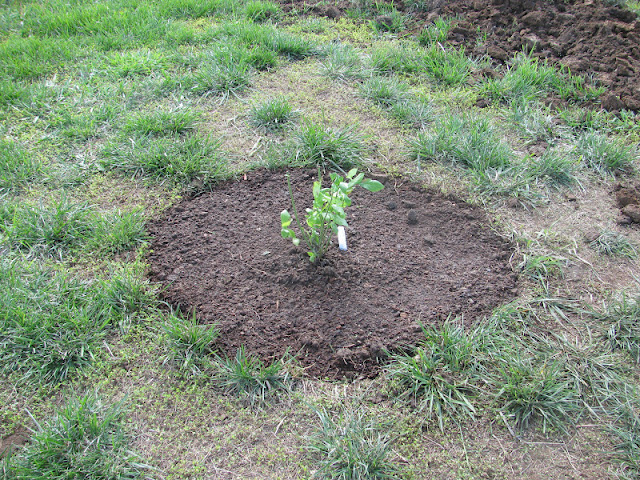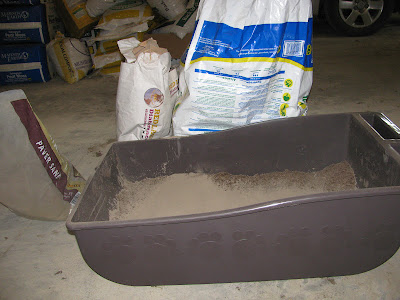When we bought our house a decade ago, it was basically brand new and it had zero landscaping. We started a garden and began to add fruit trees early on, but the areas along the foundation of our house remained depressingly bare. We've finally made a start towards fixing that with a permaculture food/flower border.
Planning
When I was designing this border, I wanted it to fulfill several functions. First, I wanted it to take advantage of the microclimate. The south side of a brick house is a great place to grow more tender plants. I also wanted to mix edible plants with those helpful to pollinators. Lastly, I wanted it to be attractive.
 |
| My initial planting plan |
Sheet Mulch
Last spring we sheet mulched a long bed around the west and south foundation of our house. First, a layer of cardboard was laid to block weeds and grass. This was topped it off with some good quality topsoil left over from our hugelkulture project, some compost, and then a 6" layer of wood chips. We let it sit for a full year.
By this spring the wood chips had decayed significantly and the soil underneath was rich, black, and full of worms.
The plants
The first plants I selected for the border were fig and wisteria. The fig I chose, Chicago Hardy Fig, is, like its name states, a more hardy selection, but it will greatly benefit from the warm southerly aspect. Wisteria is a nitrogen fixer, and native American Wisteria (Wisteria frutescens) is much less likely to grow out of control than its Asian cousins.
I also knew I wanted to try rhubarb and rosemary in this location. Rhubarb is a perennial, and I think its leaves are quite dramatic and will be a nice contrasting foilage. I have never managed to over-winter rosemary successfully in other locations on our property, so I decided to nestle in a plant close to the fig tree and hope for the best.
The other main nitrogen fixer I chose is Lespedeza thunbergii 'Gibraltar'. I have wanted to plant this for years and finally located it in a specialist nursery on the east coast. It is a truly gorgeous plant that is covered with blossoms in the fall. It will make great mulch as it has to be cut back each year, releasing nitrogen to feed its neighbors.
I decided against comfrey in the border. Comfrey is incredibly useful and (I think) beautiful, but once you plant it, you'll have it forever. I didn't want to make that commitment in this location. I decided instead to plant borage. Borage is also a great mulch plant. It self-seeds readily, but doesn't have such a tenacious root system.
The last plant I decided was a must-have is Butterfly Bush (Buddleia davidii). I know this is a controversial choice as it is not native and can be invasive in some areas. Although butterflies like it, as a non-native, it does not provide all the necessary food, habitat, etc. that natives do. After weighing it out, I decided to go ahead and plant it. I don't think buddleia is particularly rampant in NE Kansas. I will be providing many native plants, both in this border and throughout our property. The structure that a medium-sized bush will provide to the design will be welcome.
The remaining plants are a variety of flowering herbs chosen for beauty and value as medicine and/or for pollinators.
 |
| It doesn't look like much now, but with time, it will be lovely and productive |
Plant List and functions*
-American Wisteria (Wisteria frutescens) 'Amethyst Falls' - Nitrogen fixer, invertebrate shelter, nectary
-Black-Eyed Susan (Rudbeckia fulgida) - nectary, wildlife, possibly medicinal
-Blazing Star (Liatris spicata) - nectary, medicinal, wildlife
-Borage (Borago officinalis) - edible, medicinal, nectary
-Bush Clover (lespedeza thunbergii) 'Gibraltar' - Nitrogen fixer, nectary
-Catmint (Nepeta) - nectary
-Chamomile (Matricaria chamomila) - edible, tea, medicinal, nectary
-Chives (Allium schoenoprasum) - edible, aromatic confuser, nectary, dynamic accumulator, ground cover
-Coreopsis (Coreopsis verticillata) 'Moonbeam' - nectary, groundcover
-Cosmos (Cosmos bipinnatus)- nectary
-Daisy (Leucanthemum x superbum) 'Becky' - nectary
-Fig 'Chicago Hardy' - edible, medicinal
-Hyssop (Agastache) - Invertebrate shelter, nectary, medicinal, aromatic confuser
-Joe Pye Weed (Eupatorium dubium) 'Baby Joe' - nectary, medicinal
-Phlox (Phlox paniculata) - nectary
-Purple coneflower (Echinacea purpurea) - tea, medicinal, invertebrate shelter, nectary
-Rhubarb - edible, medicinal
-Rosemary - edible, tea, medicinal, nectary, aromatic confuser, invertebrate shelter, wildlife
-Russian Sage (Perovskia atriplicifolia) - edible flowers, possibly medicinal
-Salvia 'May Night' - nectary
-Sedum 'Autumn Joy' - nectary
-Wild Bergamot (Monarda fistulosa) - culinary, tea, medicinal, wildlife, invertebrate shelter, nectary, aromatic confuser
-Yarrow (Achillea millefolium) - medicinal, invertebrate shelter, nectary, dynamic accumulator, ground cover, aromatic confuser
*Functions taken from Edible Forest Gardens, Volume 2 by Jacke and Toensmeier
The future
This is definitely a work in progress. I looking forward to watching all the tiny plants fill in and to add more to the border next year. I am particularly interested in more perennial vegetables and greens. I want to add more ground cover-type plants and dynamic accumulators as well. I also plan to plant some saffron crocus bulbs. It is a bit too cold up on our windy hill to grow saffron, but I'd like to try it in the warm south-facing border.







































